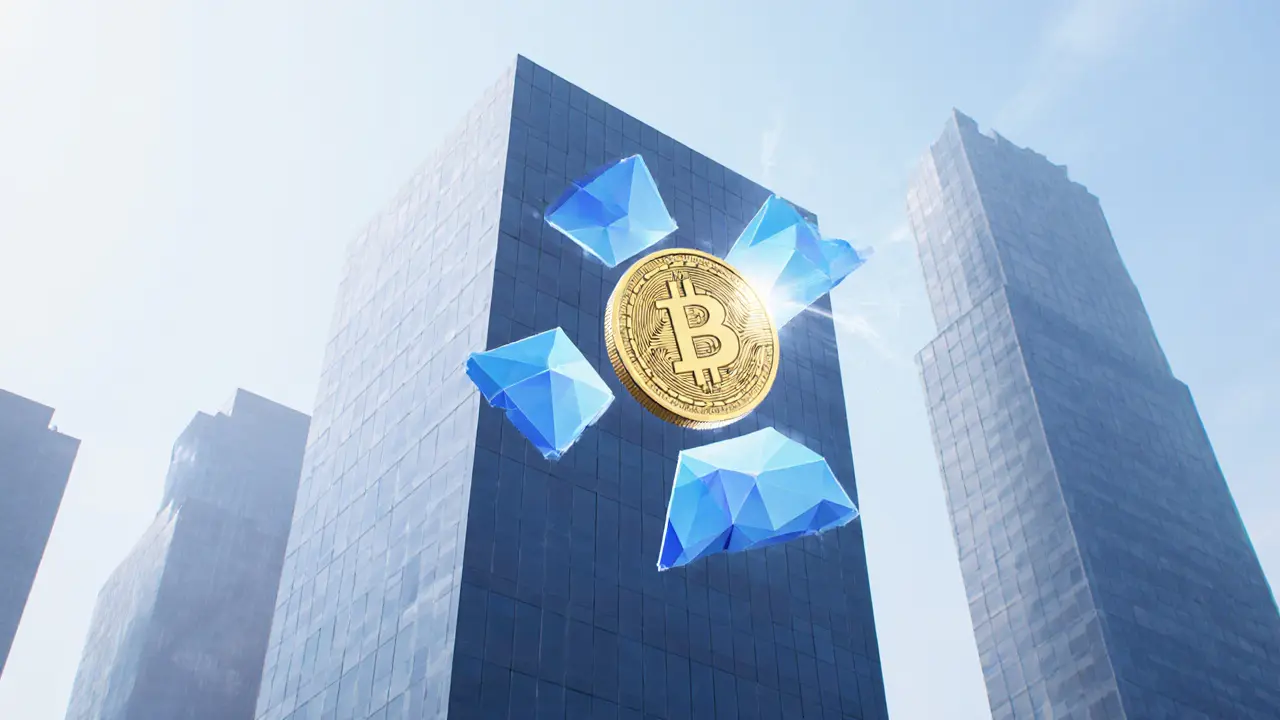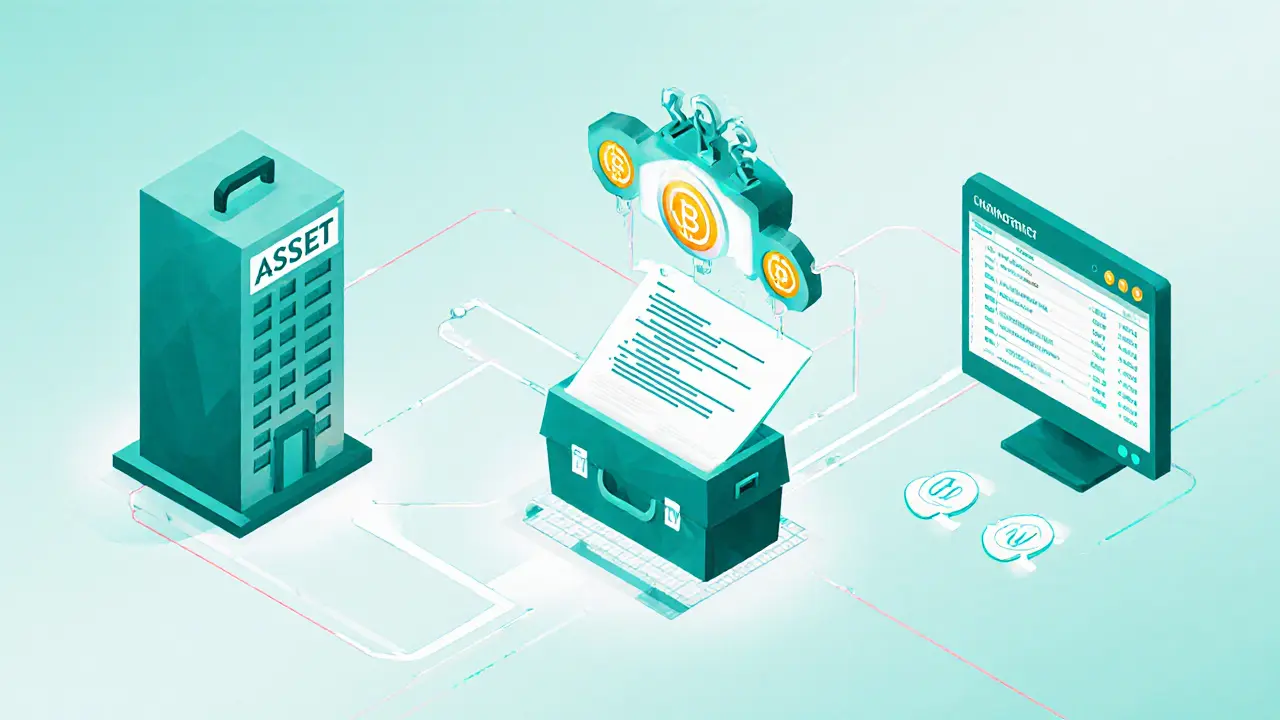Real Estate RWA Tokenization: How Blockchain Enables Fractional Property Investing

Fractional Real Estate Investment Calculator
Imagine buying a slice of a downtown office tower for the price of a dinner out. That’s what real estate tokenization is a process that turns a physical property into digital blockchain tokens, each representing a fractional ownership stake. In the past two years the market has surged past $13 billion, and analysts predict trillions of dollars will be unlocked by 2030. If you’re curious how the technology works, what it means for investors, and where the biggest risks lie, keep reading - we’ll walk through every step, compare it to classic real‑estate investing, and give you a cheat‑sheet to get started.
What Exactly Is Real‑World‑Asset (RWA) Tokenization?
At its core, RWA tokenization digitizes any tangible asset - in this case property - and locks it on a blockchain ledger. Each token is a cryptographic proof of ownership, similar to a share certificate in a public company. The most common blockchain for these tokens today is Ethereum a public, decentralized platform supporting smart contracts and ERC‑20 tokens. Tokens follow the ERC‑20 standard, making them fungible and easily tradable on secondary markets.
The End‑to‑End Tokenization Workflow
Industry guides (Mintology, 2024) outline five clear stages:
- Asset selection: Choose a property type - commercial office, residential complex, or development project.
- Legal structure creation: Form a Special Purpose Vehicle (SPV a separate legal entity holding the underlying asset and issuing tokens) to isolate liability and link tokens to real ownership.
- Token minting: Write a Solidity smart contract on Ethereum that defines total supply, token price, and dividend rules.
- Smart contract setup: Integrate oracles (e.g., Chainlink a decentralized oracle network feeding real‑world data to blockchain contracts) for rent collection, property valuation updates, and compliance checks.
- Token distribution: List the tokens on approved marketplaces (Brickken, Securitize) and begin secondary trading.
Breaking the workflow into three phases-off‑chain standardization, on‑chain mechanism, and marketplace deployment-helps teams track progress and budget. Most projects spend 60‑70% of the timeline on legal verification and SPV setup, typically 90‑150 days total.
Key Benefits Over Traditional Real‑Estate Investing
Tokenization tackles three pain points that have held real estate back from being a truly liquid asset class:
- Lower entry barriers: Investors can buy as little as $1,000 worth of tokens rather than a full property costing hundreds of thousands.
- 24/7 global trading: Unlike brick‑and‑mortar markets that close at 5 pm local time, tokens can be bought or sold anytime on digital exchanges.
- Transparent, immutable records: Every transaction is stored on the blockchain, eliminating hidden fees and enabling real‑time auditability.
When stacked against Real Estate Investment Trusts (REITs), tokenized assets trim broker commissions (3‑6% versus near‑zero on‑chain fees) and allow programmable rights-automatic dividend payouts, voting powers, or lock‑up periods-all enforced by code.
Drawbacks and Risks You Must Watch
Nothing is free. The biggest hurdles are regulatory uncertainty and technical limits:
- Regulatory gray zones: Only 37 % of jurisdictions have clear rules for RWA tokenization (World Economic Forum, 2024). Investors may face unexpected compliance costs or even forced token buy‑backs.
- Scalability bottlenecks: Ethereum processes 15‑30 TPS, far slower than Visa’s 24,000 TPS, which can cause delayed settlements during market spikes.
- Liquidity constraints: Secondary markets exist, but many tokens remain illiquid for weeks, especially if lock‑up periods are built into the smart contract.
- Legal enforceability: In most countries the token represents a share in an SPV, not direct property ownership. Courts may still need to interpret token‑based rights.
These risks mean investors should perform thorough due diligence on the platform, the SPV’s charter, and the jurisdiction’s securities regulator.

Market Snapshot - Who’s Doing What?
By the end of 2024 tokenized real‑world assets hit $13.5 billion, a 60 % YoY jump (Coinbase Crypto Market Outlook, 2025). The lion’s share of transactions occurs in:
- Switzerland, Liechtenstein, UAE, Singapore, and U.S. states like Wyoming and Colorado (78 % of global volume).
- Commercial real estate (45 % of tokenized projects), followed by residential investment (25 %) and development projects (30 %).
Institutional players are getting serious. JPMorgan piloted tokenized commercial mortgages in Q4 2023, BlackRock launched a $500 M tokenized real‑estate fund in 2023, and Fidelity filed for a tokenized real‑estate ETF in early 2024. These moves signal that the “early‑adopter” label is fading fast.
Comparison Table: Tokenization vs Direct Purchase vs REITs
| Aspect | Tokenized Real Estate | Direct Property Purchase | REIT |
|---|---|---|---|
| Minimum Investment | $1,000‑$5,000 | $100,000‑$1 M | $500‑$5,000 |
| Liquidity | Secondary markets, 24/7 (subject to lock‑up) | Low - sale may take months | High - traded on stock exchanges |
| Ownership Structure | SPV share represented by ERC‑20 token | Direct deed ownership | Shares in a corporate trust |
| Fee Landscape | 0.5‑2.5 % annual management + blockchain gas | Closing costs, property taxes, management fees | 1‑2 % expense ratio |
| Regulatory Exposure | Depends on jurisdiction; often securities law | Local land‑registry rules | SEC‑regulated |
The table shows why many investors see tokenization as a middle ground: lower cash outlay than buying whole bricks, but with more control and transparent cash‑flow than a REIT.
Step‑by‑Step Checklist for Issuers
If you’re a developer, fund manager, or property owner looking to launch a tokenized offering, follow this practical list:
- Define the asset pool: Verify title, conduct independent appraisal, and decide on token count.
- Set up an SPV: Incorporate in a jurisdiction with clear token‑regulation (e.g., Switzerland’s FINMA‑approved framework).
- Engage legal counsel: Draft offering memorandum, ensure AML/KYC compliance, and map token rights to SPV shares.
- Develop the smart contract: Use Solidity, adopt ERC‑20, embed dividend logic, and integrate Chainlink oracles for rent data.
- Audit the code: Hire a reputable firm (Trail of Bits, Quantstamp) to certify security.
- Launch a private sale: Offer early‑bird tokens to accredited investors; collect KYC info.
- List on a marketplace: Partner with Brickken, Securitize, or a regulated exchange for secondary trading.
- Implement ongoing reporting: Publish quarterly rent receipts, valuation updates, and token holder statements on‑chain.
Typical implementation costs range from $75 k to $250 k per asset, and the whole process can take 90‑150 days.

Investor Playbook - What to Look For
For retail or accredited investors, ask these questions before snapping up tokens:
- Which jurisdiction governs the SPV, and does it enforce token holder rights?
- What is the underlying property’s cap‑rate and cash‑flow history?
- Are there lock‑up periods or redemption penalties?
- Which oracle feeds rent and valuation data into the smart contract?
- Is there a secondary market with sufficient depth, and what are the fees?
Answering them will reveal whether the token is a solid income driver or a speculative play.
Future Outlook - Where Is This Heading?
Several developments suggest that tokenization will move from niche to mainstream by 2027‑2030:
- Regulatory clarity: The EU’s MiCA regime (effective Dec 2024) provides a template for other regions.
- Interoperable standards: The Blockchain Association’s Real Estate Tokenization Standard (RETS) aims to harmonize valuation reporting across chains.
- CBDC settlements: 14 countries plan to allow central‑bank digital currencies to settle token trades, reducing friction.
- Dedicated secondary exchanges: SIX Digital Exchange plans a regulated real‑estate token market in Q2 2025.
- Institutional appetite: Deloitte predicts 25 % of new commercial joint‑ventures will use tokenization for capital raises by 2027.
But the biggest risk remains fragmented regulation. If major economies adopt aligned frameworks, billions of dollars of illiquid property will finally become tradable. If not, the market could splinter into isolated silos, limiting liquidity and investor confidence.
Key Takeaways
- Real‑world‑asset tokenization translates property into blockchain‑based, fractional tokens.
- Ethereum, ERC‑20, SPVs, and oracles like Chainlink are the technical backbone.
- Benefits include low entry, 24/7 trading, and transparent ownership records.
- Risks involve regulatory uncertainty, scalability limits, and secondary‑market liquidity.
- Industry momentum is strong; by 2030 the tokenized real‑estate market could be worth trillions.
How does a token represent ownership of a physical property?
The token is linked to an SPV that legally holds the deed. Each ERC‑20 token equals one share in that SPV, giving the holder rights to dividends, voting, and a claim on the underlying asset.
What jurisdictions are most friendly to real‑estate tokenization?
Switzerland, Liechtenstein, the United Arab Emirates, Singapore, and U.S. states such as Wyoming and Colorado have clear regulatory frameworks that treat tokens as securities and allow SPVs to issue them.
Can I sell my tokens anytime?
In principle yes, but many platforms embed lock‑up periods (30‑90 days) and liquidity depends on the depth of secondary markets. Always check the token’s smart‑contract terms.
What fees should I expect as a token holder?
Typical annual management fees range from 0.5 % to 2.5 % of the asset value, plus blockchain gas fees for each transaction. Some platforms also charge a small marketplace fee on secondary trades.
Is tokenized real‑estate safe for my retirement portfolio?
It adds diversification and liquidity, but the sector is still early‑stage. Blend tokens with traditional assets and only allocate a portion of your portfolio that you’re comfortable risking.

Patrick Day
October 22, 2025 AT 08:26Sounds like the banks are just using token hype to keep us in debt.
Jenna Em
October 29, 2025 AT 22:46When you think of a token as a slice of a building, you start to see property as a shared story rather than a solitary monument. The idea that anyone can own a piece of a downtown tower challenges the old myth of exclusivity. It also forces us to ask what ownership really means in a digital age.
Benjamin Debrick
November 6, 2025 AT 14:06One must first acknowledge that the very notion of tokenizing real‑world assets is not merely a technological novelty, but rather a paradigmatic shift in the ontology of ownership; indeed, the immutability of blockchain ledgers redefines fiduciary trust in ways previously reserved for sovereign guarantees. The deployment of ERC‑20 standards, while ostensibly banal, introduces fungibility that harmonizes with traditional securities law, yet simultaneously subverts it through code‑based enforcement. Moreover, the creation of a Special Purpose Vehicle (SPV) as a legal conduit serves both to isolate liability and to map on‑chain tokens to off‑chain equity, a duality that requires rigorous statutory interpretation. From a financial engineering perspective, the fractionalization lowers the capital barrier, thereby democratizing access to cash‑flow yielding assets-a development that could reallocate capital from conventional REITs toward decentralized portfolios. However, the scalability constraints of Ethereum, constrained to roughly fifteen transactions per second, impose latency that may erode arbitrage opportunities; this is where Layer‑2 solutions such as Optimism or zk‑Rollups become indispensable. The integration of oracle networks like Chainlink provides a bridge between real‑time rent receipts and smart contract payouts, yet the reliability of these oracles is contingent upon their own governance models. Security audits, conducted by firms like Trail of Bits, are not merely a best practice but an existential necessity given the prevalence of smart‑contract exploits. Regulatory ambiguity remains the most formidable adversary: while jurisdictions such as Wyoming have codified token securities, most global regulators operate under antiquated frameworks that struggle to accommodate cryptographic assets. Consequently, diligent due‑diligence must encompass not only the technical blueprint but also the geopolitical risk matrix. In sum, tokenized real estate represents an intricate tapestry of law, technology, and finance, each thread demanding meticulous scrutiny.
Anna Kammerer
November 14, 2025 AT 05:26That’s a solid rundown, but don’t forget the human side of things. Investors still need clear, understandable reporting, otherwise the tech will feel like a black box. A good platform will push quarterly rent statements onto the chain in plain language, not just cryptic hashes.
Lindsey Bird
November 21, 2025 AT 20:46Oh, the drama of watching a $5 million office tower get sliced into tiny digital crumbs-it's like reality TV for finance!
john price
November 29, 2025 AT 12:06Look, these "digital crumbs" are a realthing, not some fancy hype. If you cant see the profit potential, ure either blind or to sit on the sidelines and regret it later. The market dont care bout your doubts.
Ty Hoffer Houston
December 7, 2025 AT 03:26From a cultural standpoint, tokenization could level the playing field for smaller investors worldwide, which is a refreshing change from the usual “big‑fish” dominance in real estate.
Ryan Steck
December 14, 2025 AT 18:46yeah but dont forget the shadowy groups pulling strings behind the scenes. every new blockchain tech is just another front for them to launder cash and control property.
James Williams, III
December 22, 2025 AT 10:06Technically speaking, the token’s smart‑contract logic enables automated distributions, which reduces administrative overhead and improves net yields for token holders.